Electronic Resources
When using Internet-based resources or e-resources, it is wise to make sure that each source is academically acceptable. Resources should meet the requirements of high school work. Typically online dictionaries include denotative meanings of words and also lists of synonyms that suggest connotative meanings. You should also find antonyms, Spanish translations, medical definitions, video tutorials, and etymologies. Here is a list of online resources that we’ll review in this lesson:
- Merriam-Webster – dictionary and thesaurus (http://www.merriam-webster.com/)
- Etymonline.com – an online etymology dictionary (http://www.etymonline.com/)
Click on the first resource from the list. The opening page is featured below:
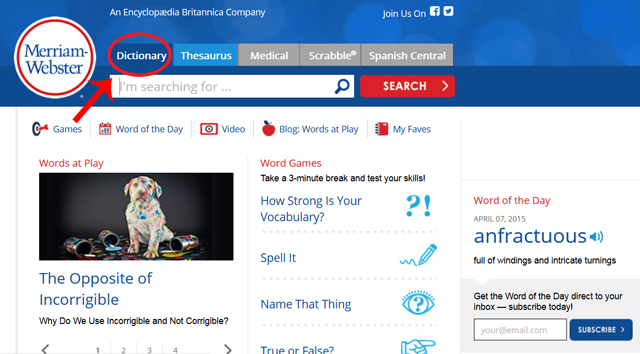
Source: screenshot, Merriam-Webster’s Online, IPSI
Notice the empty box in the middle of the screen. Above it are tabs labeled “Dictionary,” “Thesaurus,” “Spanish Central,” “Medical,” and “Scrabble”. You will use many of these tabs in this section of the lesson, but first let’s focus on the dictionary function.
Step 1: Read this sentence: “The crowd became obstreperous when they found out all the tickets were sold.” What does the word obstreperous mean? Type the word into the search box and press the magnifying glass to the right.
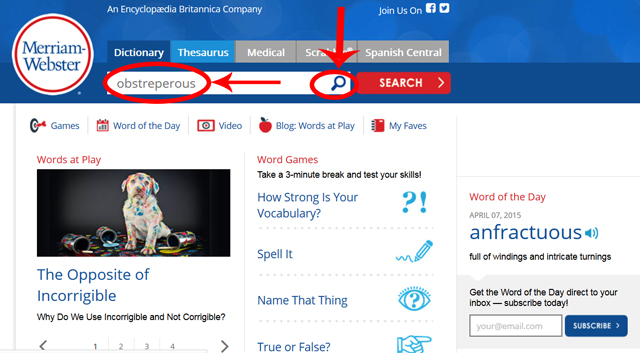
Step 2: After you press the search button, you should see a screen like this:
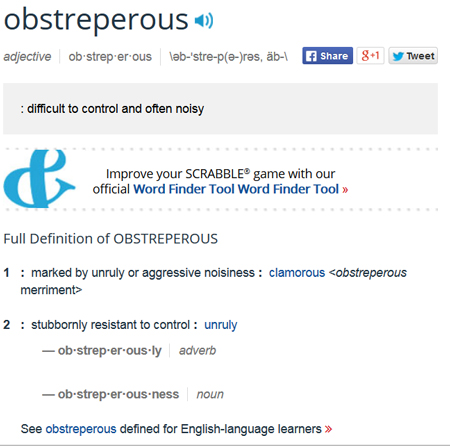
Source: screenshot, Merriam-Webster’s Online, IPSI
Step 3: At the top of the page is the word obstreperous, the part of speech (adj for adjective), and a phonetic pronunciation. The blue speaker icon provides a pronunciation of the word. Click here to listen to a pronunciation of obstreperous.
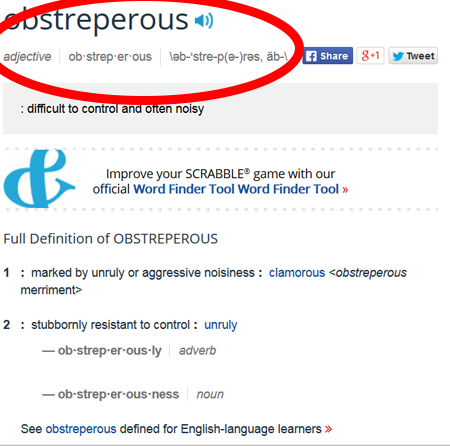
Source: screenshot, Merriam-Webster’s Online, IPSI
Below the pronunciation box, you will see the denotative meanings of the word. These are its definitions. The definition you choose depends on how the word is used in your reading or how you want to use the word in your writing.
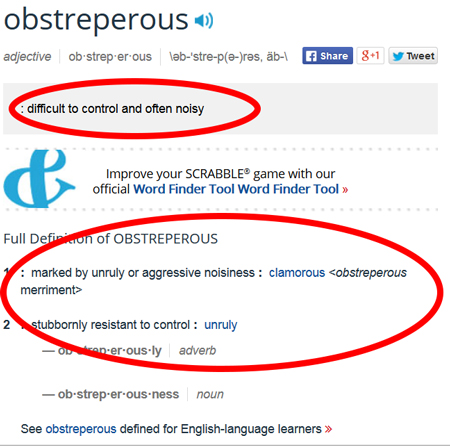
Source: screenshot, Merriam-Webster’s Online, IPSI
Further down the page are examples of obstreperous used in phrases, followed by the origin or etymology of the word (third circle in the above image). The word etymology comes from ancient Greek. It is composed of two parts: the Greek word etymon, which means “the true sense of a word,” and the Greek logia, meaning “doctrine or study.” The combination gives us “the study of the true sense of words,” which is basically the meaning of the word etymology.
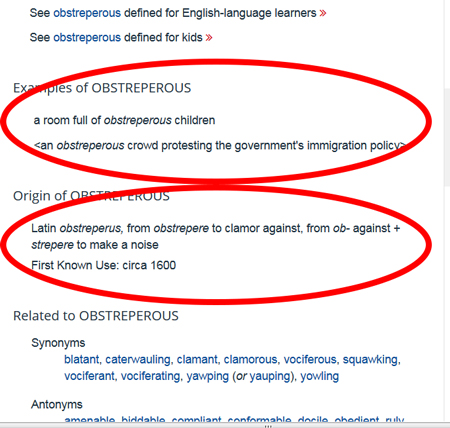
Source: screenshot, Merriam-Webster’s Online, IPSI
Step 4: The dictionary function is only one of the resources available to you on this website. Let’s look at the thesaurus function. The word is already typed in the search box. Press the thesaurus button above. You should see a screen like this:
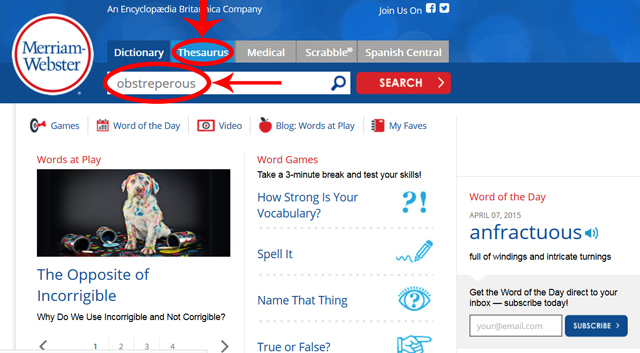
Source: screenshot, Merriam-Webster’s Online, IPSI

Source: screenshot, Merriam-Webster’s Online, IPSI
Let’s look for synonyms of the word obstreperous. On this page you can see the definitions at the top and all of the words related to obstreperous including synonyms (similar words) and antonyms (opposites). You can also click on any of those words to find out their definitions, connotations, etc.
Step 5: You can also use the Spanish Central feature, which will translate words back and forth between Spanish and English.
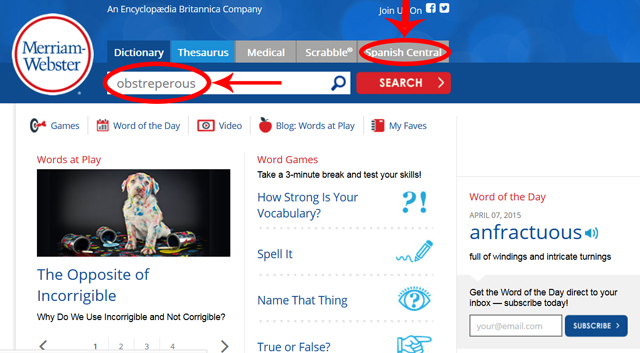
Source: screenshot, Merriam-Webster’s Online, IPSI
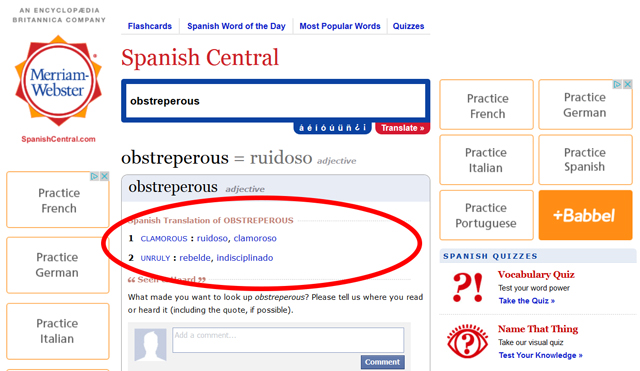
Source: screenshot, Merriam-Webster’s Online, IPSI
Now that we’ve looked up the word obstreperous and know a whole lot about it, what do you think the word means in our original sentence? Here is that sentence again: “The crowd became obstreperous when they found out all the tickets were sold.” Yes, you’re right! The crowd became unruly and uncontrollable! With your new knowledge, you can replace obstreperous with the synonyms boisterous and clamorous or translate them into the Spanish words ruidoso and clamoroso.
We discussed the word etymology at the beginning of this section. The website etymonline.com provides users with etymologies of thousands of words. Keep in mind that when you use an online dictionary, a word’s etymology will often appear near its definition. However, the Online Etymology Dictionary can supplement a traditional online dictionary or thesaurus. Here is a screenshot from etymonline.com; notice how its search functions are similar to those of the dictionary and thesaurus sites.

Source: screenshot, Online Etymology Museum (etymonline.com), IPSI
For the following exercise, use the online sources mentioned in the lesson:
Look up words in this excerpt from a speech by Elizabeth Cady Stanton, a major figure in the movement for women’s rights and suffrage. At first, the excerpt may seem difficult to understand, but by finding out what each of the highlighted words means, you should be able to put together Stanton’s message.
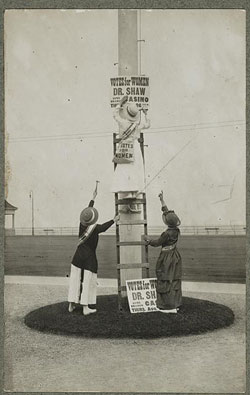
Source: “Suffrage campaign days in New Jersey,” Library of Congress
. . . In considering the question of suffrage, there are two starting points: one, that this right is a gift of society, in which certain men, having inherited this privilege from some abstract body and abstract place, have now the right to secure it for themselves and their privileged order to the end of time. This principle leads logically to governing races, classes, families; and, in direct antagonism to our idea of self-government, takes us back to monarchies [and] despotisms, to an experiment that has been tried over and over again, 6,000 years, and uniformly failed. “I do not hold my liberties,” says Gratz Brown in the Senate of the United States, “by any such tenure. On the contrary, I believe, whenever you establish that doctrine, whenever you crystallize that idea in the public mind of this country, you ring the death-knell of American liberties.”
Ignoring this point of view as untenable and anti-republican, and taking the opposite, that suffrage is a natural right—as necessary to man under government, for the protection of person and property, as are air and motion to life—we hold [the] talisman by which to show the right of all classes to the ballot, to remove every obstacle, to answer every objection, to point out the tyranny of every qualification to the free exercise of this sacred right. . . .
Now that you have read the passage and looked up each word in a dictionary, click the boxes below to answer the questions that follow.
1. Suffrage
- What part of speech is the word suffrage as it is used in this sentence?
- What is a synonym for suffrage?
2. Abstract
- Abstract is used to describe what word?
- An appropriate antonym of abstract as it is used in the passage is:
3. Antagonism
- What is the antagonism directed toward in the speech?
- The etymology for antagonism is:
4. Despotisms
- What part of speech is the word despotisms as it is used in this sentence?
- What does despotism mean?
5. Uniformly
- What word does uniformly describe in the sentence?
- What is an antonym for uniformly?
6. Tenure
- What part of speech is tenure as it used in the sentence?
- What is a synonym for tenure?
7. Doctrine
- What does doctrine mean in the sentence?
- What is doctrine referring to in the passage?
8. Knell
- What is a synonym of knell?
- What is the main language for the etymology of knell?
9. Untenable
- What idea does untenable mean?
- What is untenable in the passage?
10. Talisman
- In the passage, what is held as a talisman?
- What is the main language for the etymology of talisman?
 Now that you’ve looked up a lot of words from Stanton’s speech, use your notes to explain what she is saying about suffrage or the right to vote. When you’re finished, check your understanding to see a possible response.
Now that you’ve looked up a lot of words from Stanton’s speech, use your notes to explain what she is saying about suffrage or the right to vote. When you’re finished, check your understanding to see a possible response. Sample Response:
In this passage, Elizabeth Cady Stanton argues that this “right to vote” is actually a gift handed down from one group of powerful men to another in order to keep a select group of men in power. She points out that in a self-governing democracy such as ours, this sort of exclusivity is dangerous to our liberties. She ends her argument by stating that the only way to break out of this dangerous practice of restricting the right to vote to powerful males is to open up the vote to all genders and classes and let the people choose whom they wish to be in public office.